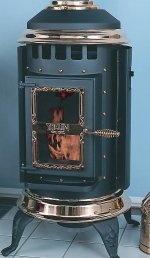Search engine visitors - click here to access entire "$ensible Home" web site
Click here to see a descriptive illustration of several types of pellet heaters, freestanding stoves and inserts.
Related links - Fireplace Usage and Safety Tips
Dear Jim: I thought about installing a corn or wood pellet stove to help heat my home. Will they save money, will they work when the electric power goes off and are they convenient to use? - Chris G.

A: Installing a corn or pellet heater (also often called stove) can lower your utility bills overall and they are very convenient to use. I have used a pellet heater to supplement my heat pump since 1990. Every two days, I dump a 40-pound bag of pellets into the hopper and empty the ash pan twice a month. Mine has battery backup so it continues to heat my house when the electricity goes off.
Corn is even a better fuel than wood pellets for heating a home. With the high efficiency, up to 82 percent, of corn heaters (also burn pellets), they are the cheapest source of heat for a home. Using pellets is more expensive than corn, but still much cheaper than using the heat pump at my house.
Using renewable corn or pellets is earth-friendly and good for our country. All corn and wood is homegrown, so the money stays here and creates local jobs. They both also burn very cleanly causing little air pollution. Pellets are made from waste sawdust, so they are basically a recycled fuel.
Corn weighs about 60 pounds per bushel. You can buy it at any feed store or directly from a farmer. They weigh the amount you want and charge as little as $2.50 per bushel. Pellets are available in 40-pound bags at many major home centers, wood heater stores, feed stores, and some supermarkets.
Pellet and corn heaters look identical and are attractive with large glass doors to view the fire. Some use very ornate styles and others have a high-tech look. They offer attractive options such as real 24-karat gold and brass trim. Insert models are available to fit in an existing fireplace.
Since they are so efficient, these heaters do not need a chimney. They are vented outdoors by a four-inch pipe through an outside wall, so you can locate one in any room in your home. The room where your family congregates is good one so it stays toasty warm and they can enjoy watching the flames.
A pellet or corn heater/stove has a small auger (screw) that slowly feeds the firepot. The auger speed is adjustable to control the heat output. Wall thermostats are also available for automatic use. Optional glow plug igniters automatically light the pellet or corn fire. With up to an 85-pound hopper capacity, a heater can run for several days without refilling.
A draft blower draws combustion air through and over the pellets and forces it outdoors. This creates a slight vacuum inside the heater so no smoke gets indoors. These fuels burn so cleanly, you won't even see any smoke coming from the pipe outdoors. Burning corn creates a wonderful sweet scent outdoors.
Instant Download Update Bulletin No. 880 - buyer's guide of 14 corn/wood pellet heater/stoves, types (freestanding and fireplace inserts), heat outputs, hopper capacity, heating capacity listed in square feet, burn time in hours, vent options, auger/feed design, features, illustrations, descriptions of the types of pellet appliances, and a fuel cost (corn, pellets, gas, propane, electricity, oil, wood) comparison chart.
Dear Jim: We have a bathroom faucet that runs for about five seconds and then the water slows to a trickle. It happens each time we turn it on. What could be causing this problem and how can I fix it? - Scott W.
A: It sounds as if there is something floating in your pipes or inside the faucet. When you turn on the water, it carries this object along until it hits a narrow spot and slows the water flow.
If you are lucky, it may be a broken piece of rubber washer inside the faucet. Take it apart and replace it. If it is somewhere else in the plumbing, you may have to cut a pipe open to remove the object.